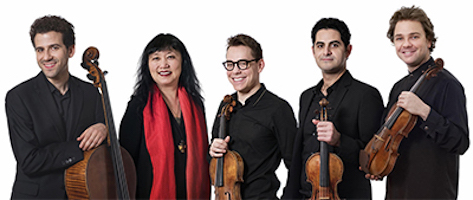by Nicholas Stevens

When pianist Wu Han introduced the Tuesday Musical program on March 12 in Akron’s E.J. Thomas Hall, featuring members of the Chamber Music Society of Lincoln Center, the promise that the concert would end with a work by Sergei Taneyev lent the evening rare coherence and drive. That composer, little-known in the U.S., was a student and colleague of Tchaikovsky, and a teacher of Rachmaninoff and Prokofiev — whose works were also featured on the program.
Rachmaninoff wrote his Trio élégiaque as a student of Taneyev. Barely even touching his strings, cellist Nicholas Cannelakis initiated whispery oscillations that soon passed to Wu Han and violinist Alexander Sitkovetsky. Throughout, the players maintained uncanny coordination. Wu Han played with the sureness of motion and controlled potential energy of a coiled spring, letting one sub-bass note rattle the air as the string players formed an aching chord above. Later, just before the concluding funeral march, a similar move created a breathtaking texture.
Listeners may not often find themselves hunting for futurism in Tchaikovsky’s Souvenir d’un lieu cher, but in this program built around lines of influence, something of Prokofiev seemed to lurk in the tune of the second movement. A teacher of Taneyev, Tchaikovsky refused to dampen his characteristic overtones of anxiety in even this relatively light piece. Sitkovetsky served up low melodies with glutinous indulgence as Wu Han added offbeat palpitations.
Arnaud Sussman joined Sitkovetsky for Prokofiev’s Sonata for two violins, one of a handful of pieces by the Taneyev student in which virtuosity, provocation, and emotional chilliness coincide. Highlights included the first movement, when half-step clashes tickled the eardrums, and the third, when the glittering tones of the players conjured images of a Siberian tundra in sunlight.
By the first minute of Taneyev’s 45-minute Piano Quintet, for which violist Matthew Lipman joined the ensemble, Wu Han’s message about this composer’s influence crystallized. As with Rachmaninoff, the piano exerts a gravitational pull on all other players, not to mention on the listener’s attention. Yet the intense string melodies smack of Tchaikovsky, and Prokofiev’s steeliness glints through the Romantic surface.
With her staggering dynamic range and gift for texture, Wu Han remained squarely in charge throughout. However, each string player had moments to shine: Cannelakis played high and with intensity in the first movement, never sounding or looking strained. Sussman and Sitkovetsky laid into moments of that movement with a passionate abandon rarely heard outside Mahler symphonies, and Lipman seized the spotlight with a rich-toned solo in the Scherzo second movement.
Published on ClevelandClassical.com March 25, 2019.
Click here for a printable copy of this article



